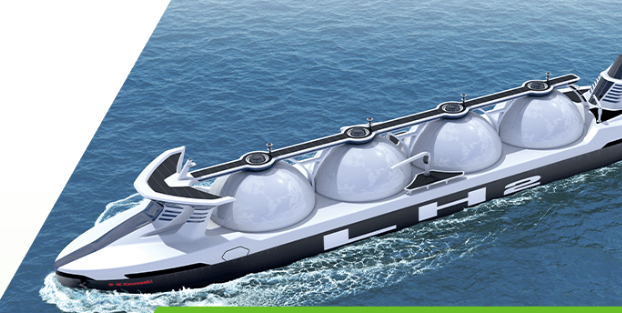Kawasaki Vision for the Future
Today, our society is mostly dependent for energy on fossil fuels such as petroleum or natural gas.
This is causing the serious environmental problem of global warming and the risk of natural resource depletion. “Hydrogen Energy” offers a solution for securing a stable energy supply and the preservation of the global environment.
Hydrogen has been referred to as the “Ultimate Clean Energy.” It can be used like petroleum as fuel to power automobiles, and like natural gas to generate electricity.
Besides, unlike fossil fuels, hydrogen does not emit carbon dioxide when combusted to produce energy.
We will be able to continue to drive cars and use electricity with hydrogen.
Our daily lives will not change. But thanks to hydrogen energy, our society can be changed dramatically.
Through hydrogen energy, Kawasaki hopes to bring a new future to the people of the world.
This initiative, which draws on the integrated capabilities of the whole Kawasaki Group, has already started.
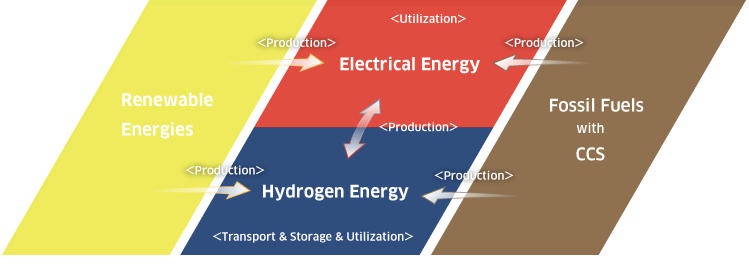
Hydrogen: The Ultimate Energy Clean and Powerful
Hydro, một loại năng lượng sạch không thải ra CO 2 khi sử dụng, có thể thu được từ nhiều nguồn. Việc chuẩn bị cơ sở hạ tầng để sử dụng hydro làm nguồn năng lượng đang bắt đầu trên toàn cầu.
“Sản xuất”, “Vận chuyển/Lưu trữ” và “Sử dụng” hydro.
Kawasaki có các công nghệ tương thích cao với từng quy trình này. Công nghệ của Kawasaki sẽ liên kết các địa điểm sản xuất hydro với người tiêu dùng năng lượng, và làm như vậy sẽ khai sinh ra Con đường Hydro.


Hydrogen Production
Production from Brown Coal
The “Hydrogen” solution takes advantage of previously unused resources
Despite its great potential, brown coal goes unused because, for various reasons, it cannot be transported to consumers. The solution to convert brown coal to “hydrogen” enables practical use of previously unused resources. The power of hydrogen will create a new path called the “Hydrogen Road” between energy production sites and consuming sites.
Brown coal that exists about five meters underground in Latrobe Valley, Australia.
The reserves are estimated to be equivalent to 240 years' worth of total electric power generation in Japan.
Hydrogen is produced from brown coal, and then transported to Japan by liquefied hydrogen carriers.
* Brown coal is an early stage coal, plant fossil, that is less than 100 million years old. It has not been widely used because of spontaneous ignition causing problems in transportation and storage.
Production from Renewable Energy
Mother Nature cannot be controlled by humans.
As power generation using renewable energy becomes widespread, the stability of the power supply becomes an issue.
If excess power is stored in the form of hydrogen, it can be used whenever needed by those who need it.
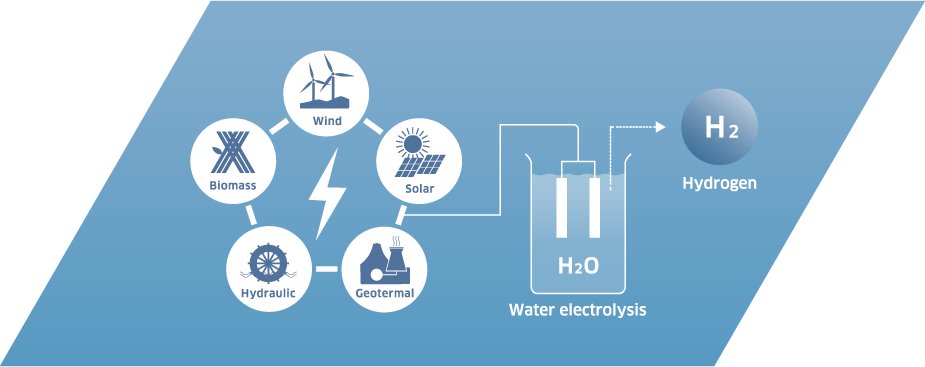
Hydrogen
Transportation & Storage
Liquefied Hydrogen: The Key to Large-Volume Transportation
Kawasaki’s cryogenic technology makes large-volume transportation of hydrogen possible.
When cryogenically cooled to -253°C, hydrogen changes its phase from a gaseous state (GH2) to a liquid state (LH2), shrinking to 1/800 of its original volume. At its reduced volume, storage and transportation efficiency increases dramatically, enabling a much greater distribution of hydrogen.
Transportation of hydrogen in liquefied form is one of the highest efficient methods.
This technology is already commercially used.
Kawasaki’s many years of experience of providing liquefied natural gas (LNG: at -162℃) carriers, storage tanks and receiving terminals, and cryogenic liquefied hydrogen storage tanks is utilized in this area.
Kawasaki already possesses the key for the state-of-the-art technologies of the mass transportation of hydrogen for the foundation of a hydrogen energy society.
Realizing -253°C: Cryogenic Temperature
Developed Japan’s first industrial-scale hydrogen liquefaction system with Kawasaki’s proprietary technology.
The developed hydrogen liquefaction system is installed in the Hydrogen Technology Demonstration Center at the Harima Works, and has the capacity to liquefy approximately 5 tonnes of hydrogen per day.
This system is built upon Kawasaki’s technology of handling cryogenic materials and the turbine technology we have cultivated in the development of high rotational speed machinery.


Transportation
Marine transport
Japan’s first LNG carrier was built by Kawasaki.
Kawasaki will introduce the world’s first liquefied hydrogen carrier.
To make utilization of hydrogen as a viable next-generation energy, technology is required to transport large quantities of hydrogen efficiently and safely. Kawasaki built Japan’s first LNG carrier in 1981. Since then Kawasaki has been a leader in cryogenic technology for maritime transportation. We are the rare player who can combine the shipbuilding and liquefied hydrogen cryogenic technologies.
LNG carrier
-162°C LNG carrier: 40-year Kawasaki pride.
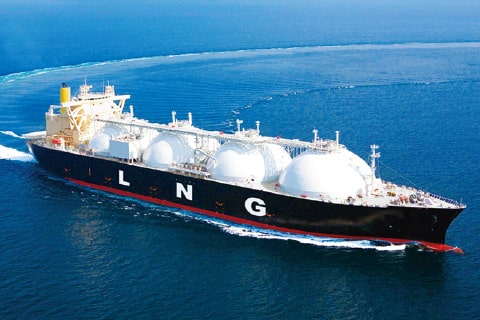
Pilot liquefied hydrogen carrier "SUISO FRONTIER"
More than 40 years have passed since the first Japan-built and first Asia-built LNG carrier was built. The world's first liquefied hydrogen carrier "SUISO FRONTIER" is being built and currently in its final stage.
The pressurized cryogenic cargo containment system specifically for LH2 was developed successfully based on Kawasaki's existing technologies of LNG carrier building and of LH2 land transportation and storage. The LH2 carrier is designed and built based on the safety requirements approved by the IMO* as interim recommendations.
LH2 needs to be maintained at some 100°C below that of LNG and easily evaporates. The carrier is now advancing final preparations towards technological demonstration transporting an Australian-produced liquefied hydrogen.
*IMO: International Maritime Organization
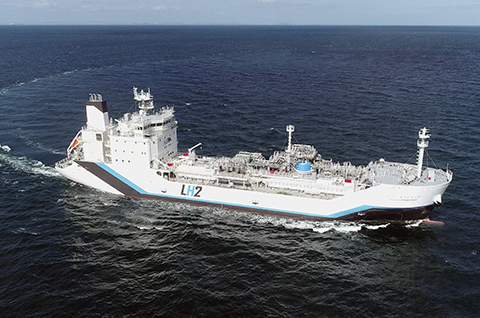
Large-scale liquefied hydrogen carrier
Should a society where hydrogen is widely used be realized, it will be necessary to carry large quantities of low-cost hydrogen produced overseas to Japan. Hydrogen, the ultimate clean energy. When hydrogen becomes an energy source as common as coal, oil and natural gas, Kawasaki-developed large-scale liquefied hydrogen carriers will support its distribution.
Transportation
Land transport
Liquefied hydrogen containers
Liquefied hydrogen containers to enable land transportation of liquefied hydrogen
As demand for hydrogen energy increases, land transportation will be required to bring large quantities of liquefied hydrogen to consuming sites. The insulation technology we developed for our LNG storage tanks enables transportation of liquefied hydrogen at -253°C.
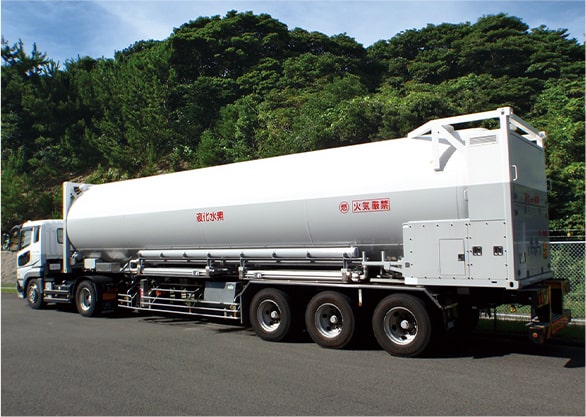
Compressed gaseous hydrogen trailer with composite cylinders
Compressed gaseous hydrogen trailers to meet various transportation needs
With fuel cell vehicles to enter the market, preparation of hydrogen filling stations is already underway. Kawasaki has developed Japan’s first compressed hydrogen trailer with composite cylinders, which will enable hydrogen to be transported from domestic hydrogen production facilities to offsite hydrogen stations, be stored there in the trailer itself, and be supplied to fuel cell vehicles.
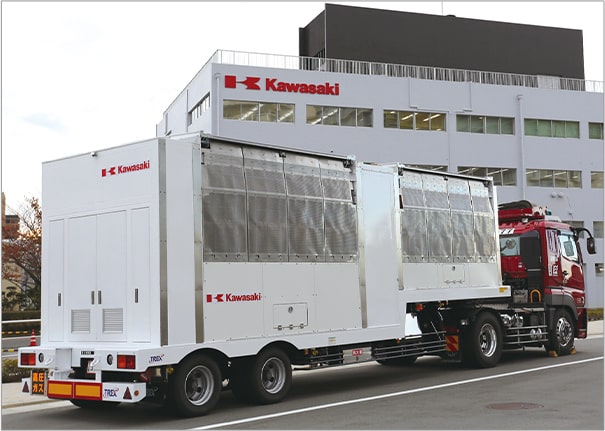
Storage
Kawasaki Technology:
Built on more than 30 years of working with rocket fuel
Through the development of the liquefied hydrogen storage tanks at JAXA (Japan Aerospace Exploration Agency)’s Tanegashima Space Center rocket launch facilities, as well as liquefied hydrogen containers for land transportation, Kawasaki has cultivated technology to transport and store -253°C cryogenic liquefied hydrogen safely. Kawasaki technology, based on a long, successful history of dealing with hydrogen, will be instrumental in building the hydrogen energy network.
Liquefied hydrogen storage tanks
Largest Japanese domestic liquefied hydrogen storage tank, equipped with advanced insulation technology for minimising boil-off gas
In a liquefied hydrogen storage tank, heat from the sun and other external factors cause the stored liquid to evaporate. This is known as boil-off gas, and technology to minimise its formation is essential for long-term storage of liquefied hydrogen. To maintain the -253°C conditions needed for storing liquefied hydrogen, Kawasaki developed even more advanced thermal insulating technology than used in our LNG storage tanks to keep boil-off gas formation to the absolute minimum. For 30 years, our high-performance liquefied hydrogen storage tanks have supported the endeavours of the JAXA Tanegashima Space Center – a testament to the deep trust placed in Kawasaki technology.
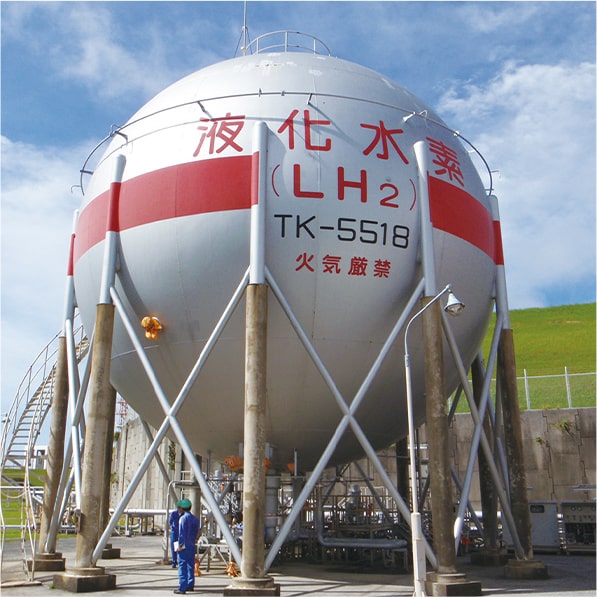
Kobe Liquefied Hydrogen Receiving Terminal "Hy touch Kobe"

Kawasaki completed the Kobe LH2 terminal "Hy touch Kobe" on Kobe Airport Island, which consists of a loading arm system (LAS) transferring liquefied hydrogen as its cryogenic temperature of -253℃, a liquefied hydrogen storage tank, and related facilities.
The LH2 terminal is now undergoing the world’s first technology demonstration, international hydrogen energy supply chain.
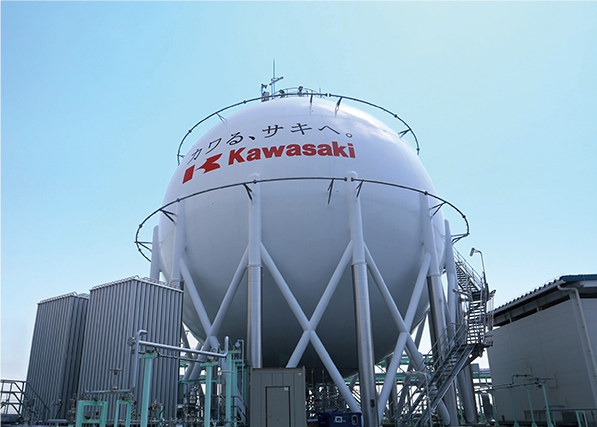
Hydrogen Utilization
Future Society with Widespread
Hydrogen Energy Utilization in Sight
When widespread utilization of hydrogen energy starts, society will change a great deal. Fuel cell vehicles that run without emitting CO2 will become commonplace, and everything from mobility to electricity generation will be efficiently powered by clean hydrogen. Hydrogen will contribute to greater energy efficiency while helping to realise an environmentally friendly society. This dream energy will help create a sustainable future.
Hydrogen technology for gas turbines
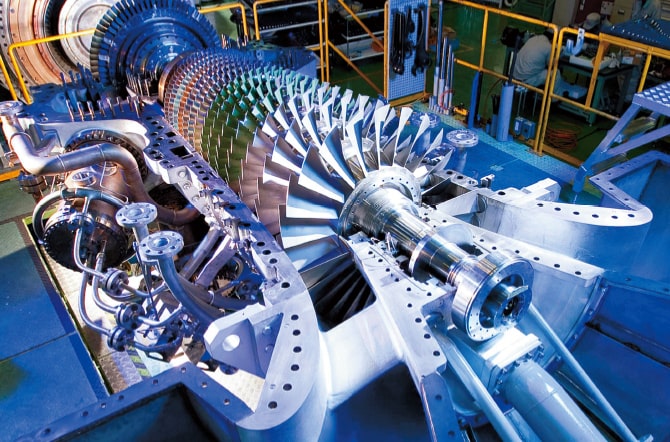
One of the most effective utilization of hydrogen energy is the hydrogen gas turbine power generation.
Kawasaki has developed a proprietary technology of combustion using only hydrogen or natural gas as well as any mixture of them. The newly developed combustion technology enables the existing natural gas turbine to be utilized without modification to its main body, and the whole turbine system to be capable of adapting to the hydrogen's unique combustion property.
In the spring of 2018, the demonstration was successfully completed by supplying four neighboring public facilities with heat and power simultaneously using a gas turbine power generation system in an urban area fueled by hydrogen alone. It was the world's first.
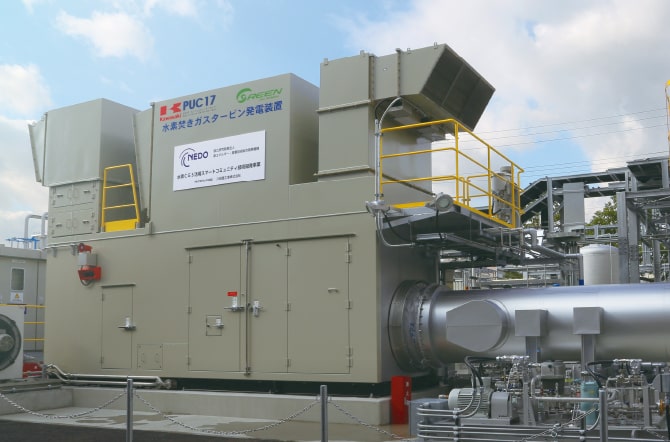
Smart Community Technology Development Project Utilizing Hydrogen Cogeneration Systems
Kobe Port Island
This demonstration project utilizes a co-generation system(CGS*1) with hydrogen gas turbines.
On a former site of Minatojima Clean Center we constructed a co-generation system with a 1 MW-gas turbine fueled by hydrogen and natural gas.
Theme by NEDO*2 (FY 2015 to 2018) in cooperation with Obayashi Corporation, the City of Kobe, and major corporations in the Kansai area. This is the first attempt in the world to supply heat and power generated from hydrogen to an urban area.
- CGS is a collective name for systems that supply heat and power.
- NEDO National Research and Development Agency, New Energy and Industrial Technology Development Organization

Wet Type Combustor
Hydrogen and Natural Gas Fueled Burner
How Kawasaki combine conflicting factors?
A difference between a conventional gas turbine and a hydrogen gas turbine lies in the combustor.
Instead of designing it only for hydrogen, Kawasaki devised a technology so that natural gas, hydrogen, or mixture of them can be used as its fuel flexibly. However, it is required a technology to resolve conflicting factors such as stable combustion and reducing NOx emission at the same time.
Hydrogen is almost a part of our society.
This demonstration project generates heat and power from hydrogen and supplies them to public facilities nearby.This is the first project of this kind in the world in an urban area.Hydrogen is almost a part of our society.
『Hydrogen Only Dry Low NOx Combustion Technology』
Advancement of Hydrogen Technologies and Utilization Project
The Birth of a New Technology featuring “7 Times” Flame Propagation Speed plus High Combustion Temperature
Hydrogen burns with a flame velocity about 7 times faster than that of natural gas and at a higher combustion temperature. For this reason, technically, burners that use hydrogen need to overcome a range of problems such as fuel nozzle burnout, unstable combustion, and increasing NOx emission.
In practice, this means that advanced technology is required in order to develop a combustor that can cope with the characteristics of hydrogen combustion.
For instance, in order to protect the fuel nozzle from the high flame temperature, the nozzle is coated with a ceramic. In response to the issue of increasing NOx emission with higher flame temperature, Kawasaki inject water to lower the flame temperature, but in fact this worsens the fuel economy. So Kawasaki developed pure hydrogen fueled Dry Low NOx combustion technology as a totally new idea to overcome this issue. The principle is to subdivide the fuel and eject it from tiny nozzles roughly the diameter of the core of a mechanical pencil, so that the fuel burns in a “microflame.” Kawasaki call this technology “Micromix.” With the Micromix combustor, it is possible to burn 100% pure hydrogen while suppressing NOx emission without water injection. As a result, the realization of CO2 zero-emission power generation is now just around the corner.
* The results of the present research were obtained from the following researches. In FY 2014 and 2015, one research was conducted as a Cross-ministerial Strategic Innovation Promotion Program (SIP) and “Energy Carrier” project supported by the Council for Science, Technology and Innovation (CSTI) (Funding agency: JST). From FY 2016 through 2018, the other research has been conducted as Advancement of Hydrogen Technologies and Utilization Project, an outsourced project of the national research and development corporation New Energy and Industrial Technology Development Organization (NEDO).
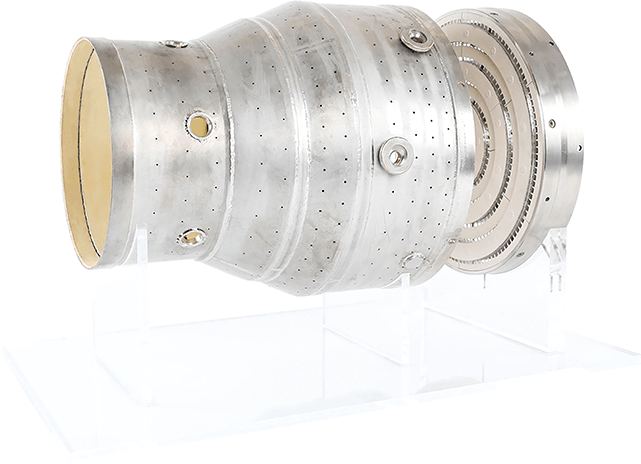
<Hydrogen Only Dry Low NOx Combustion Technology>
With this technology, the fuel is divided into small amounts by ejecting from tiny nozzles roughly the diameter of the core of a mechanical pencil. Kawasaki call this next-generation type burner technology “Micromix.”

